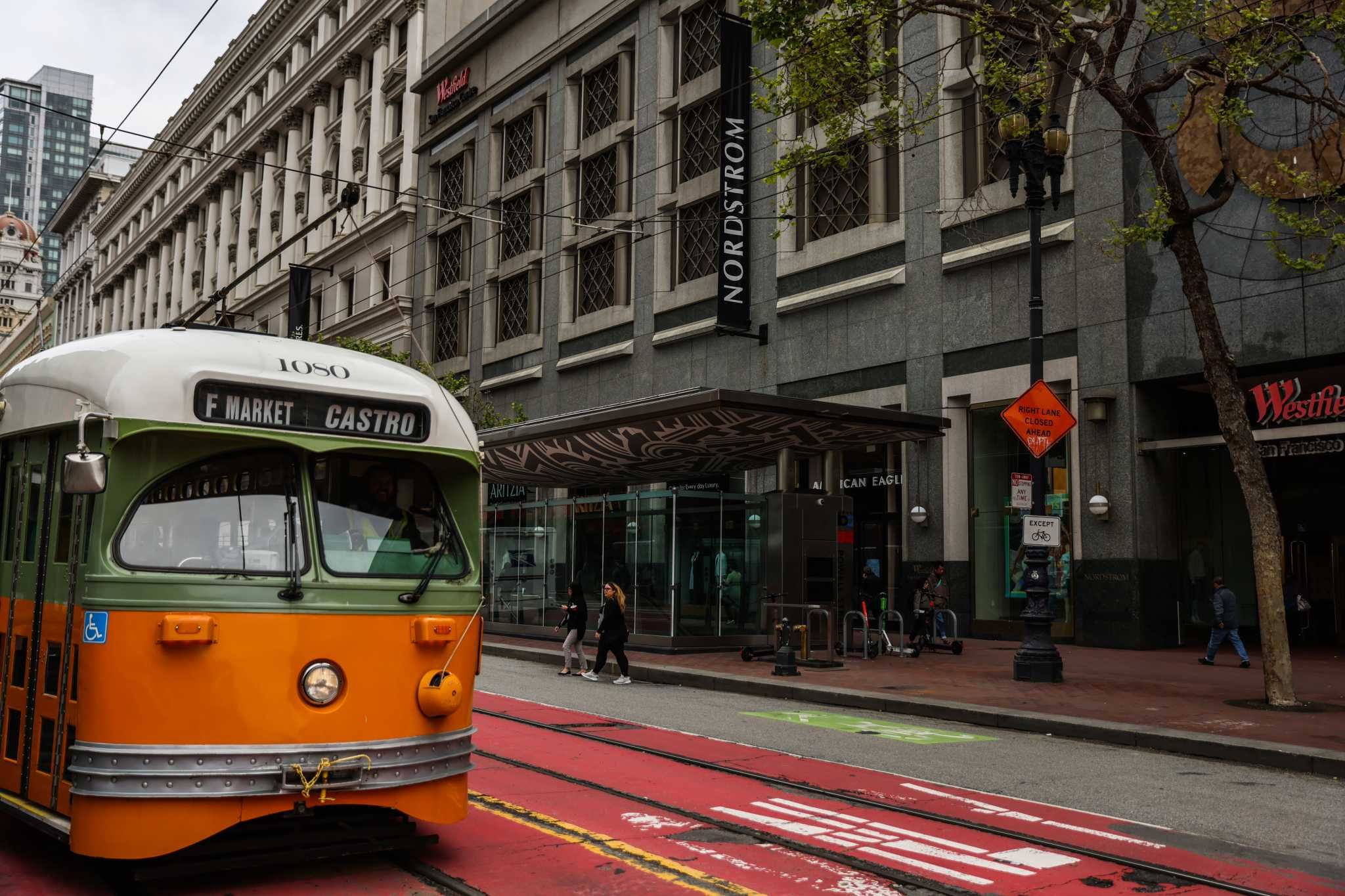Westfield mall blamed SF Nordstrom closure on 'rampant' crime
The impending closures of two Nordstrom stores and Saks Off 5th in downtown San Francisco has added more fuel to the debate over the role of crime in pushing retailers out of the city’s core.
Nordstrom said downtown “changed dramatically over the past several years, impacting customer foot traffic to our stores and our ability to operate successfully,” without specifically citing public safety concerns in a staff memo.
Unibail-Rodamco-Westfield, which owns the Westfield mall where Nordstrom is closing, was more blunt, with a spokesperson blaming the city for “unsafe conditions” and a “lack of enforcement against rampant criminal activity.”
Those claims are backed up with crime data that shows retail theft has risen in San Francisco in the last few years. But some measures of criminal activity such as 911 calls at Market and Fifth streets are lower than pre-pandemic levels, suggesting there’s less foot traffic and shopper activity, which in turn may fuel a perception of increased danger.
Statewide data shows that San Francisco has a high rate of shoplifting reports compared to the rest of California and nearby Bay Area counties.
More for you Listen: Nordstrom joins exodus from troubled downtown
According to the FBI’s Uniform Crime Reporting data, the city saw 304 shoplifting reports per 100,000 residents in 2021, up 14.7% from 2019’s 265 reports per 100,000 residents and nearly double 2020’s 162 per 100,000 residents.
In contrast, California’s rate in 2021, the most recent data available, was 163 per 100,000 residents, which remains below 2019’s level of 228 reports per 100,000 residents and was flat compared to 2020.
Shoplifting reports fell across the state in 2020 as many retailers and malls were closed for in-person shopping during pandemic health orders.
Lea Suzuki/Associated Press
Across the bay, Alameda County saw shoplifting reporting rates rise to 222 per 100,000 residents in 2021 from 162 in 2020, but remain below 2021’s level of 228. To the south, Santa Clara County had 115 reports per 100,000 residents, flat compared to 2020 and below 2019’s rate of 155.
“San Francisco does stand out compared to the rest of the state,” said Magnus Lofstrom, policy director of criminal justice and senior fellow at Public Policy Institute of California, a nonpartisan think tank, who provided the data.
While property crime is relatively high in San Francisco, violent crime rates are relatively low compared to other major U.S. cities, data from local police districts shows.
Annual murders have increased in San Francisco during the pandemic, but that matches an upward trend across the state and nationally, Lofstrom said.
Shoplifting data comes with caveats.
San Francisco is a center of tourism and — more so before the pandemic — a destination for office commuters who live outside the city, which boosts its daytime population. That means there are more potential victims and perpetrators of crimes who aren’t accounted for in the city’s total population, which raises the crime rate compared to cities that don’t see as many visitors, Lofstrom said.
San Francisco Police have also said shoplifting incidents are underreported. “It’s incomplete data. A lot of incidents aren’t reported to law enforcement,” Lofstrom said.
It isn’t clear how much of a factor public safety was in Nordstrom’s decision to close. Another major retailer, Whole Foods, cited safety concerns when it temporarily shuttered its biggest San Francisco store, located at Eighth and Market streets, last month.
Gabrielle Lurie/The Chronicle
Another metric of crime is the number of 911 calls at a particular city intersection.
At Fifth and Market streets — adjacent to Nordstrom, Nordstrom Rack and Saks Off 5th — annual 911 calls plunged from 3,951 in 2019 to 1,163 in 2020 and have continued to drop with 913 in 2021 and 897 in 2022. That doesn’t necessarily mean the area is safer, but likely is tied to a lower volume of foot traffic following pandemic health restrictions, fewer tourists and remote work.
Larceny theft reports, which include shoplifting, have increased in the Tenderloin Police Station district, which includes Westfield mall, but remain below 2019 pre-pandemic levels.
In the first four months of 2023, those reports rose 22% to 567 incidents from 465 incidents in the same four months in 2022. Reports soared in all of 2022 to 1,800 incidents, up 43% from 1,251 incidents in 2021, and 1,088 in 2020. But 2019 saw more reports: 2,535.
When it comes to reducing retail crime, there’s no obvious solution, said Lofstrom. Part of the challenge is that there’s no clear data on what percentage of theft is perpetrated by organized criminals or those looking to profit off of the goods, in contrast to destitute people stealing food or other essentials as a means of survival.
“It’s difficult to say exactly what can be done about this,” he said. “Research strongly points to a higher number of police deterring theft.”
In March, the Board of Supervisors approved $25 million to fund additional police overtime. Supervisor Matt Dorsey, who represents South of Market and the Westfield mall area, is working on a potential ballot measure that would increase police staffing.
“There’s been a challenge of recruitment and retention,” Lofstrom said of policing. “It’s something we’re seeing around California and something that holds true for San Francisco as well.”
On Wednesday, merchants around nearby Union Square sought to highlight signs of economic progress for the area, which included a packed free tulip giveaway in March, more tourists and some new store openings.
“We are as committed as ever to brick-and-mortar in the district,” said Lauren Ellis, director and partner at CK Contemporary, an art gallery that is celebrating its 10th anniversary, in a statement. “We are excited about the momentum that has been building in the neighborhood as we navigate out of the past few challenging years.”
Midday on a rainy Wednesday, it was quiet outside on the Market Street entrance to Westfield mall. A security guard stood inside the door looking outward.
“I was surprised by the lack of people. I thought it would be a lot busier,’’ said Colin Burns, a visitor from Wellington, New Zealand, who was exiting the mall.
Arum Kathuria of San Francisco was not surprised to learn Nordstrom would be closing and expected other retailers to be following behind. “Shoplifting and store safety is the biggest reason behind it,” he guessed. “I’ve seen shoplifting, plenty.”
Natasha Burr, of San Francisco, came downtown to have a look after she heard Nordstrom would be closing. But she won’t miss it.
“I think shopping malls are a terrible idea,’’ she said on her way in. “I’m interested in them taking the mall and turning it into housing and mixed use.”
Mayor London Breed and Board of Supervisors President Aaron Peskin have proposed making it easier to open offices, entertainment and other uses into vacant retail spaces. The Planning Commission is set to vote on the measure on Thursday.
One couple that did not seem fazed by reports of crime in the mall or on the streets were Maria Magana and Gabriel Teele, who came in from Richmond.
“I feel like it is worse in Richmond than it is here,” Magana said. “Public safety is a big issue, but it’s not that big of an issue for us. We’re used to it,” Teele said.
Source: San Francisco Chronicle


